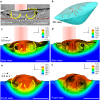Pore evolution mechanisms during directed energy deposition additive manufacturing
- PMID: 38402279
- PMCID: PMC10894260
- DOI: 10.1038/s41467-024-45913-9
Pore evolution mechanisms during directed energy deposition additive manufacturing
Abstract
Porosity in directed energy deposition (DED) deteriorates mechanical performances of components, limiting safety-critical applications. However, how pores arise and evolve in DED remains unclear. Here, we reveal pore evolution mechanisms during DED using in situ X-ray imaging and multi-physics modelling. We quantify five mechanisms contributing to pore formation, migration, pushing, growth, removal and entrapment: (i) bubbles from gas atomised powder enter the melt pool, and then migrate circularly or laterally; (ii) small bubbles can escape from the pool surface, or coalesce into larger bubbles, or be entrapped by solidification fronts; (iii) larger coalesced bubbles can remain in the pool for long periods, pushed by the solid/liquid interface; (iv) Marangoni surface shear flow overcomes buoyancy, keeping larger bubbles from popping out; and (v) once large bubbles reach critical sizes they escape from the pool surface or are trapped in DED tracks. These mechanisms can guide the development of pore minimisation strategies.
© 2024. The Author(s).
Conflict of interest statement
The authors declare no competing interests.
Figures








References
-
- DebRoy T, et al. Additive manufacturing of metallic components—process, structure and properties. Prog. Mater. Sci. 2018;92:112–224. doi: 10.1016/j.pmatsci.2017.10.001. - DOI
-
- Piscopo G, Iuliano L. Current research and industrial application of laser powder directed energy deposition. Int. J. Adv. Manuf. Technol. 2022;119:6893–6917. doi: 10.1007/s00170-021-08596-w. - DOI
-
- Wolff, S. J. et al. In situ X-ray imaging of pore formation mechanisms and dynamics in laser powder-blown directed energy deposition additive manufacturing. Int. J. Mach. Tools Manuf. 166, 103743 (2021).
Grants and funding
LinkOut - more resources
Full Text Sources

